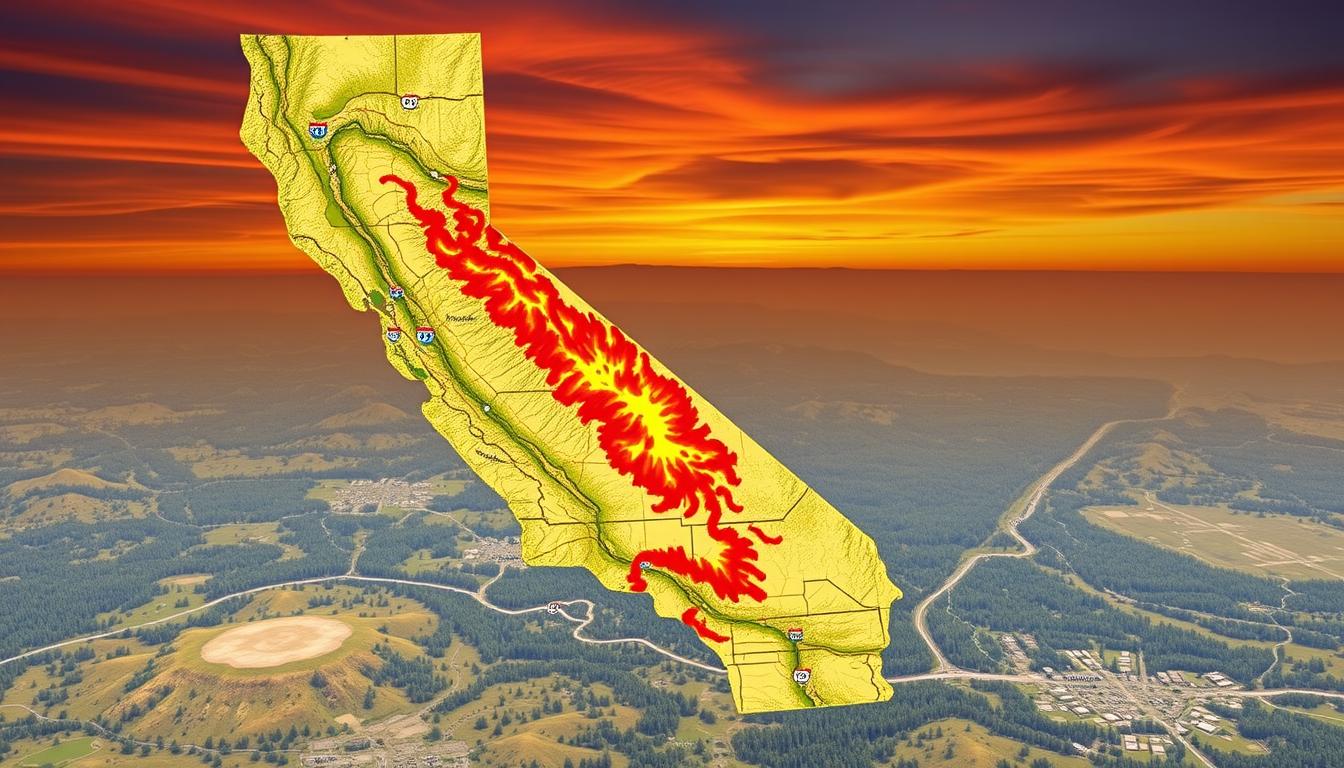The California fires map is a must-have for anyone in or visiting the state, especially during wildfire seasons. In 2023, California saw 7,127 wildfires and over 324,917 acres burned. Knowing the current wildfire map helps residents stay informed and react quickly.
With most fires happening in spring, summer, and early fall, a real-time map is key. It helps communities stay safe and strong against wildfires.
Key Takeaways
- Stay updated with the real-time California fires map for safety.
- 2023 reported over 324,917 acres burned across the state.
- Access to timely information helps in emergency preparedness.
- Wildfire incidents are most common during the late summer and fall.
- Understanding fire patterns can enhance community resilience.
Understanding the California Fire Landscape
California’s diverse ecosystems and climate are key to its wildfire patterns. Many factors affect how often and how big wildfires get. Knowing this landscape is vital for both residents and firefighters.
Types of Fires in California
California sees different types of wildfires, based on where they happen and the environment:
- Forest Fires – These happen in dense woods.
- Grass Fires – Found in open fields, they spread fast.
- Brush Fires – Fueled by shrubs and small trees, they grow quickly.
Historical Context of Wildfires
California has faced big wildfires for years, with ten of the biggest in the last decade. Fire management has changed from Native American methods to modern suppression. Now, over 97% of the state is in severe or extreme drought, making wildfires more likely.
Effects of Climate Change
Climate change has made wildfires worse in California, with longer seasons and hotter temperatures. Air temperatures have gone up over 3.5 degrees since the late 1800s. This has led to about 78 more fire days a year than 50 years ago.
These changes mean more wildfires and harm to landscapes and communities.
Tools like the wildfires in california map and california fire map live updates help locals deal with these issues. They keep people informed about fires near them.
The Importance of a Real-Time California Fires Map
The interactive California fire map is a vital tool for communities facing wildfire threats. It offers real-time data, helping residents stay updated on fires and stay safe.
Keeping Communities Safe
Over 100,000 people are under evacuation orders or warnings due to wildfires. The Palisades Fire has burned over 17,200 acres. The map gives updates, helping people evacuate quickly.
Supporting Emergency Services
Emergency teams use the map to plan their efforts. They fight fires like the Eaton Fire, which has burned nearly 11,000 acres. Real-time data helps them send firefighters where they’re needed most.
Enhancing Public Awareness
The map helps protect people and raises awareness about risks. With looting in evacuated areas, staying alert is key. It encourages people to take action, keeping their homes safe.
| Fire Incident | Area Burned (acres) | Structures Destroyed | Death Toll |
|---|---|---|---|
| Palisades Fire | 17,200 | 5,316 | 5 |
| Eaton Fire | 11,000 | Under assessment | 0 |
| Sunset Fire | 43 | Under assessment | 0 |
Where to Find the Latest California Fires Map
It’s important to stay informed about wildfires in California. The latest california fires map offers updates on fires, evacuation orders, and fire perimeters. Here are the best places to find accurate and timely information.
Official State Resources
California’s official sites give regular updates on fires. CAL FIRE has a user-friendly map for the latest fire information. It shows real-time fire updates, containment levels, and affected areas. It’s a key tool for everyone.
Mobile Applications
Mobile apps are great for getting updates based on your location. The Frontline Wildfire Defense App is a top choice. It sends alerts and helps users track fires with a wildfire tracker california map. These apps connect users to firefighting efforts and community resources.
News Media Outlets
News outlets often report on wildfires, helping raise awareness. Mainstream news covers fire updates, evacuation orders, and local impacts. These reports provide critical information, helping people understand wildfire risks.
How to Interpret the California Fires Map
Understanding the california fire map live updates is key for everyone. It shows fire severity, affected areas, and wildfire details. With real-time data, users can make quick, informed decisions.
Understanding Fire Severity Levels
Fire severity levels are divided into three: minor, moderate, and large-scale. Each level shows the fire’s danger. Knowing these levels helps in planning responses and actions.
Recognizing Affected Areas
The map uses icons and colors to show wildfire impacts. It’s easy to see which areas are most at risk or damaged.
- Red icons: Indicate high-severity areas.
- Orange icons: Show moderate-fire zones.
- Yellow icons: Represent minor incidents.
Utilizing Map Features
The california fire map live updates has useful features:
- Thermal hotspot indicators: Show active flames and heat.
- Fire perimeters: Outline fire spread areas.
- Evacuation zones: Mark mandatory evacuation areas.
| Severity Level | Icon Color | Description |
|---|---|---|
| High | Red | Significant fire threat; immediate action required. |
| Moderate | Orange | Noticeable fire activity; monitor closely. |
| Minor | Yellow | Low fire impact; minimal concerns. |
With these insights and tools, people can better handle wildfires. They can stay ahead during emergencies.
Emergency Preparedness Tips for Residents
Wildfires are a big threat in California. Being ready can save lives and reduce risks. Knowing how to evacuate, having emergency kits, and staying informed are key. Here are some tips to help you prepare.
Creating an Evacuation Plan
Having a clear evacuation plan is essential. Know at least two ways to leave your home and practice them. The California fires map can show the safest routes based on fire data.
Plan a meeting spot outside danger zones. This ensures everyone’s safety. Also, be aware of dangers around your home, as most fires start from embers.
Assembling an Emergency Kit
A good emergency kit is crucial. Sadly, only 35% of homes are fully prepared. Your kit should include:
- Three gallons of water per person
- A three-day supply of non-perishable food
- First aid supplies and medications
- Flashlight and battery-powered radio
- Important documents in a waterproof bag
Having a “go bag” with these items can greatly improve your readiness. The wildfire tracker California map helps with updates on fire locations, prompting evacuations.
Staying Connected with Local Alerts
Staying in touch with local alerts is crucial. Sign up for emergency notifications on apps and social media. This way, you get updates on fire threats and evacuation orders.
Real-time info from places like the Los Angeles Fire Department keeps you informed. Make sure your communication devices work during emergencies.
Real-Time Updates and Notifications
It’s crucial to stay informed during wildfires to stay safe. Real-time updates and notifications help a lot. They let people know about wildfires through the california fire map live updates and other sources.
Sign-Up for Emergency Alerts
People should sign up for emergency alerts from local and state authorities. These alerts give quick info on evacuations, fire updates, and safety tips. This way, you get alerts that are right for your area during emergencies.
Recommended Apps for Instant Alerts
There are apps that send instant alerts about wildfires. The Frontline Wildfire Defense App alerts users based on their location. These apps use a real-time fire map california to help people stay updated and make quick decisions.
Social Media for Live Updates
Social media is also great for wildfire updates. State agencies and local fire departments post important info on their official accounts. By following these accounts, people can get the latest on wildfires and access current data.
Community Resources for Fire Victims
After devastating wildfires, community resources are key for victims. They offer help and guidance as they recover. Knowing about these resources can make a big difference.
Assistance Programs
Many groups help those hit by wildfires. The American Red Cross has set up shelters with supplies like cots and blankets. They help without asking for ID.
For more help, call the 24/7 Disaster Distress Helpline at 1-800-985-5990.
Support Groups
Meeting others who’ve gone through similar things can help. There are many support groups for wildfire victims. They share experiences and find ways to cope.
These groups offer emotional support and info on recovery. The Red Cross Emergency app can find local shelters and support groups.
Local Government Services
Local services are vital for recovery. The California DMV gives free replacements for lost documents in fire areas. FEMA helps with disaster assistance.
CalWORKs and CalFresh offer financial and food help. Local Assistance Centers in affected areas provide many services to help people rebuild.
The Role of Technology in Fire Management
Technology has changed how California fights wildfires. New tools help agencies respond faster and safer. This makes sure they can tackle fires on the current fires in california map effectively.
Drones and Aerial Surveys
Drones are key in watching wildfires. They have high-resolution cameras and can get close to fires safely. Their images, combined with satellite data, create an interactive california fire map. This map gives real-time updates to firefighters.
ALERTCalifornia’s AI cameras can zoom in and out. They take pictures every two minutes, up to 120 miles at night.
Predictive Modeling Software
Predictive software helps forecast fire behavior. AI systems can spot smoke and send images to fire departments. This helps them plan and use resources better during emergencies.
This technology is now available to all CAL FIRE 911 Dispatch Centers. It makes decision-making faster and more effective.
Firefighting Innovations
New firefighting tech is crucial. FLIR lets firefighters see through smoke, helping them plan better. Single-engine air tankers and bigger planes drop fire retardants and water, helping control fires.
LiDAR technology creates detailed 3D maps. These maps help analyze fire behavior and plan for the future. They reduce risks by guiding land management.
| Technology | Application | Benefits |
|---|---|---|
| Drones | Real-time aerial surveys | Enhanced monitoring and mapping |
| AI Systems | Smoke detection and alerts | Quick response and accuracy |
| FLIR Technology | See through smoke | Improved strategic planning |
| LiDAR | 3D mapping and fuel load calculation | Informed land management |
Environmental Impact of California Fires
Wildfires in California cause more than just immediate damage. They harm wildlife habitats and air quality. Knowing about these effects helps us understand why we need to watch fire conditions closely.
Damage to Wildlife Habitats
Wildfires destroy wildlife habitats, leading to loss of homes for animals. The California Department of Fish and Wildlife manages about 1,100,100 acres of these habitats. It’s vital to protect these areas to keep biodiversity alive.
More fires mean more changes in forests. Non-native species grow, pushing out native plants and animals. This changes the forest’s makeup forever.
Air Quality Concerns
Wildfires also harm air quality, spreading smoke and particles far and wide. People in these areas face breathing problems and health issues. It’s crucial to stay updated with the wildfire tracker to stay safe.
Dry conditions and strong winds make air quality even worse. This creates a dangerous environment for those living in fire-prone areas.
Long-term Ecological Effects
Wildfires can change the landscape for good. High-severity fires make it hard for ecosystems to recover. They lead to lasting losses of native plants.
Climate change makes droughts worse, weakening ecosystems. More fires and changing conditions make recovery harder. This threatens the balance of California’s unique ecosystems.
Engaging with Local Fire Safety Efforts
Getting involved in fire safety is key for a safer community. People can join many efforts to fight wildfires. These actions make our neighborhoods safer and bring us together.
Knowing the current fires in California map helps us plan better. It guides us in managing fires effectively.
Volunteer Opportunities
Volunteering for fire prevention can make a big difference. Groups need help for tasks like:
- Helping with clean-up days to cut down fire risks.
- Supporting events to teach people about fire safety.
- Assisting during evacuations in fire zones.
Community Education Programs
Learning about fire safety is crucial. Local groups offer programs to teach us about:
- Understanding the california fires map and updates.
- Creating emergency plans and evacuation routes.
- Using fire-resistant landscaping and home designs.
Fire Prevention Initiatives
Fire prevention efforts are vital for our safety. The California Fire Safe Councils work with locals to find solutions. They focus on:
- Assessing fire risks in neighborhoods.
- Working with first responders for safety plans.
- Encouraging safe land use to reduce hazards.
By joining these efforts, we all help protect our community. This makes our neighborhoods safer and more prepared for fires.
Future Outlook: Reducing Fire Risks
California is working hard to tackle severe wildfires. New ways to manage forests are key to this fight. Controlled burns and thinning trees help reduce fire risks and make forests healthier.
These efforts make communities safer from fires. They help keep everyone safe.
Innovations in Forest Management
New forest management uses advanced tech to watch over forest health. The interactive california fire map shows fire risks in real-time. It helps plan where to do controlled burns and thin trees.
This reduces the chance of big fires.
Legislative Efforts in California
California’s government is making laws to better manage fires. They’ve increased funding for CalFire a lot. This money helps with fire prevention and teaching communities.
It’s important for people to know about these laws. They help keep everyone safe from wildfires.
Public Awareness Campaigns
There are campaigns to teach people about wildfire risks. They use the california wildfire map today to help. By knowing about fire risks, communities can protect themselves.
These campaigns teach about creating safe spaces around homes. This can help save lives in a wildfire.
Conclusion: Staying Prepared and Informed
It’s very important for people to stay alert and informed, especially with wildfires in California. The California fires map is a key tool, giving real-time data to help keep everyone safe. Using a wildfire tracker california map can also save lives and property during emergencies.
Recap of Key Resources
Using local resources is key for emergency preparedness. It’s a good idea to have a ‘go-bag’ ready with important items and supplies. Joining local Fire Safe Councils can also help, offering info on evacuation routes and shelters.
The FEMA App and text alerts from the Department of Homeland Security can keep you updated on fire conditions.
Final Thoughts on Fire Preparedness
Fire preparedness is a team effort. Working together and sharing knowledge helps communities face wildfires better. By using available tools, we can protect lives and properties.




